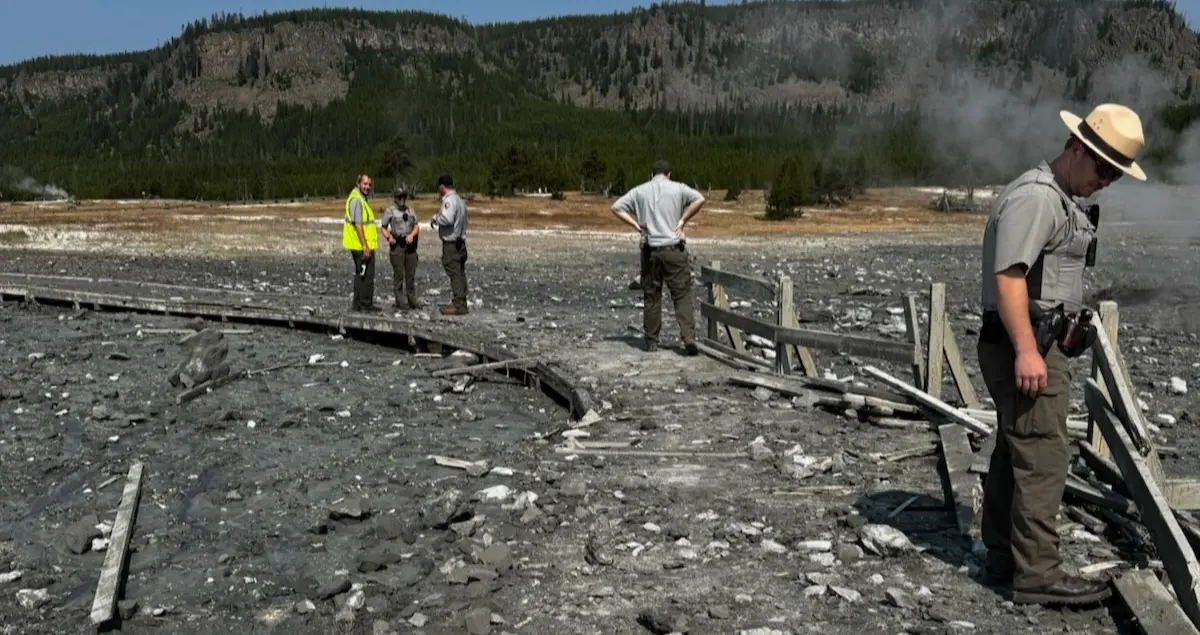Yellowstone National Park, July 23, 2024 – Biscuit Basin, a popular geothermal area in Yellowstone National Park, has been temporarily closed following a hydrothermal explosion. This incident has raised concerns among visitors and park officials alike.
What Happened?
On the morning of July 23, 2024, a sudden hydrothermal explosion occurred in Biscuit Basin. The explosion sent steam, water, and rock fragments into the air. The area is known for its hot springs and geysers, which are fueled by the park’s underground volcanic activity.
Understanding Hydrothermal Explosions
A hydrothermal explosion happens when water trapped underground is rapidly heated by magma. The water turns into steam and expands, causing an explosion. In this case, the explosion created a small crater and scattered debris over a wide area. These explosions are rare but can be very powerful.
Immediate Response
Park rangers quickly responded to the explosion. They evacuated visitors from the area to ensure their safety. The park administration decided to close Biscuit Basin temporarily. This closure is to allow experts to assess the damage and ensure it is safe for visitors to return.
Visitor Safety
Safety is a top priority at Yellowstone National Park. The park has numerous signs and guidelines to keep visitors safe. However, the natural geothermal features can still be unpredictable. Rangers constantly monitor these features for any signs of unusual activity.
History of Hydrothermal Activity in Yellowstone
Yellowstone is famous for its geothermal activity. It has more than 10,000 hydrothermal features, including hot springs, mudpots, fumaroles, and geysers. These features are a result of the park’s location over a hotspot in the Earth’s crust.
Biscuit Basin itself is named after biscuit-shaped deposits that were formed around Sapphire Pool after an earthquake in 1959. The area is known for its vibrant hot springs and active geysers. Despite the natural beauty, these features can be dangerous.
Previous Incidents
This is not the first time a hydrothermal explosion has occurred in Yellowstone. In the past, similar incidents have taken place. These events remind us of the dynamic and ever-changing nature of the park’s geothermal features.
Expert Analysis
Geologists and park experts are currently studying the site of the explosion. They aim to understand the causes and potential risks. Early reports suggest that an accumulation of pressure underground led to the explosion. Monitoring equipment is being used to detect any further changes in the geothermal activity.
Impact on Wildlife
Yellowstone is home to a diverse range of wildlife. The park’s geothermal features create unique habitats for many species. While the explosion has disturbed the area, there have been no reports of significant harm to wildlife. However, park officials are keeping a close watch on the situation.
Visitor Reactions
Many visitors were in the park at the time of the explosion. Some witnessed the event from a safe distance. Reactions have been mixed. Some visitors expressed disappointment at the closure, while others were amazed by the power of nature.
One visitor, Jane Collins from Ohio, said, “It was scary but fascinating. We were on a trail when we heard a loud bang and saw steam rising. The rangers did a great job of getting everyone to safety.”
Plans for Reopening
The park administration is working on a plan to reopen Biscuit Basin. This plan includes a thorough safety inspection of the area. Any unstable ground or hazardous debris will be addressed. The goal is to ensure that visitors can safely enjoy the beauty of Biscuit Basin.
Preventive Measures
To prevent future incidents, the park is enhancing its monitoring systems. More sensors are being placed in key areas to detect changes in temperature and pressure. Rangers are also receiving additional training on how to respond to geothermal emergencies.
Educational Programs
Yellowstone offers several educational programs about its geothermal features. These programs help visitors understand the science behind the hot springs and geysers. The park hopes to use this recent event as a teaching moment. By educating visitors, they can better appreciate and respect the power of nature.
Visitor Guidelines
While the park is a place of wonder, it’s important to follow safety guidelines. Visitors should stay on designated paths and boardwalks. They should also heed warning signs and listen to ranger instructions. This helps ensure not only their safety but also the preservation of the park’s natural features.
The Bigger Picture
Yellowstone is one of the most geologically active areas in the world. Its geothermal features are a key part of its charm and scientific value. Incidents like the hydrothermal explosion at Biscuit Basin highlight the need for ongoing research and vigilance.





Leave a Reply